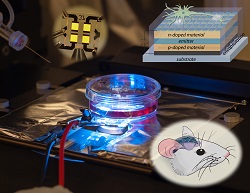OLEDs for better control of neurons
We might not realise it, but neurons are at the heart of our capacity to make sense of and interact with our environment. Thanks to optogenetics, these cells can now be controlled with high precision using light, with potential applications in the cure of neurological diseases or visual impairment. This technique does, however, rely on LED or laser light sources which lack precision and spatial resolution, meaning that they are often unable to control individual neurons. ‘Delivering light from these sources to the relevant region of the brain in a live animal typically requires holding the animal underneath a microscope or introducing bulky and rigid components that do not conform to the soft tissue and, thus, may influence the animal’s behaviour,’ explains Caroline Murawski, Marie Skłodowska Curie fellow at the University of St Andrews. With funding under the NEUROLED (Organic Light-Emitting Diodes for Optogenetic Control of Neurons) project, Murawski is aiming to overcome these limitations by structuring OLEDs to sub-cellular length scales with an extremely high resolution, so as to allow quick switching between targeted cells over large areas. The possibility of producing these OLEDs on flexible substrates also means that they could eventually be adapted to the shape of the targeted organ in vivo. ‘I envision that OLEDs will be able to individually address thousands of cells at once and that their mechanical flexibility will be highly beneficial for bio-implantation,’ Murawski enthuses. The project uses photolithography to obtain OLED pixels with sizes of 10-100 μm, depending on the required spatial resolution. The OLEDs emit colours matching the activation spectrum of genetically-introduced light-sensitive proteins, and include electrically-doped charge transport layers with high conductivity to achieve high brightness at low driving voltages – therefore generating minimum resistive heating that would otherwise spread to the adjacent cells. As the efficiency of OLEDs typically strongly decreases at higher brightness, Dr Murawski had to balance the two aspects by using fluorescent emitters instead of the phosphorescent compounds that are widely found in commercial OLEDs. ‘Another difficulty is the quick degradation of OLEDs when they come in contact with water,’ Murawski adds. ‘In order to target cells with high spatial resolution in the aqueous environment that is naturally required for cell growth, the organic materials need to be protected with a very thin encapsulation film. Here, we follow two routes: using oxides and polymers that are grown by chemical vapour deposition, and employing ultra-thin flexible glass encapsulation sheets.’ The next step for Murawski and her colleagues in the group of Prof. Malte Gather was to use their high brightness OLEDs for proof of concept optogenetics experiments. Their plan consists in growing cells directly on top of the OLEDs or to implant miniature versions of the devices into live animals. As Murawski explains, the OLEDs are then driven with ms-long current pulses, generating high-power light pulses that evoke action potential firing in adjacent neurons. ‘We have used the larvae of Drosophila melanogaster (fruit flies), which is a model organism in genetics, for our proof of concept. We have demonstrated that OLEDs achieve the required brightness levels to stimulate the larvae’s neurons and were able to control the larval behaviour with our devices. We are now working to demonstrate that OLEDs can evoke waves of action potentials in cultures of primary neurons, and to combine this with optical readout of neuronal activity.’ Thanks to this research, neuroscientists will benefit from a tool allowing completely new experiments, for instance studies of the pattern of network activity as systematically inhibitory neurons are added or removed. This would provide a powerful yet simple model for studying medical conditions such as Alzheimer’s disease. ‘Flexible OLEDs may also be used as bio-implantable light sources to empower well-defined stimulation of certain regions of the brain in animal studies, or further down the line potentially even in patients. We are already working with a large US-led consortium to develop prosthetics and we are hoping to win funding from a UK charity to develop and use OLEDs for a basic research-oriented neuroscience study,’ Murawski concludes.
Keywords
NeurOLED, OLED, LED, optogenetics, neurons, neural network, postehetics, alzheimer’s, drosophila, neuroscience

